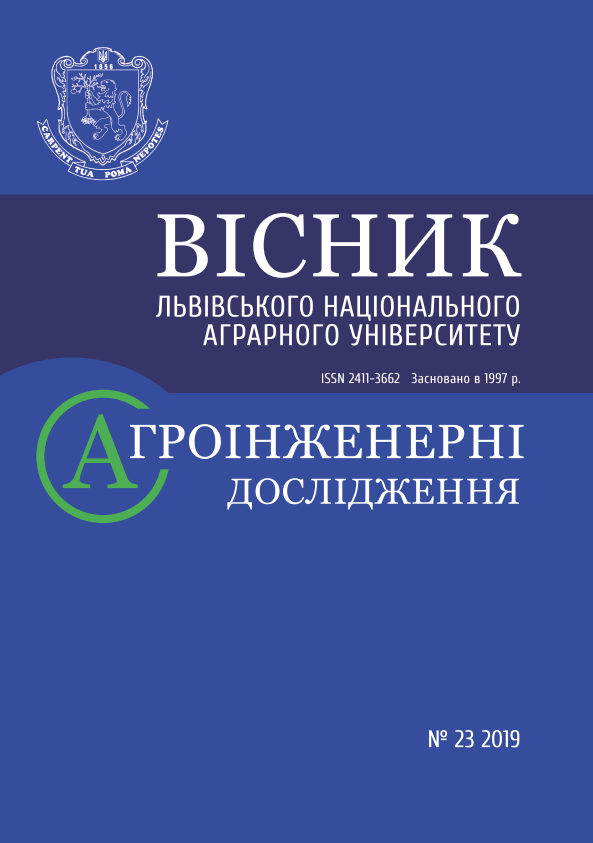KINEMATIC ANALYSIS OF LEVER MECHANISMS WITH AN INTERNAL MOVING LINK
DOI:
https://doi.org/10.31734/agroengineering2019.23.013Keywords:
Non-Assur structural group, internal moving link, rod, rocker arm, hydraulic cylinder, hydraulic actuator, bucket, excavator, crane, kinematic characteristicsAbstract
The paper studies the mechanism with an internal moving link, which is used in many different machines. It is the main mechanism of cranes with hydraulic astuator of the boom, and it forms a complex mechanical system of steering of dumps, ladles and other loading equipment of wheeled and tracked tractors.
In the studied mechanism, the drive rod may move reciprocating with respect to the cylinder and pivotally coupled to the rocker arm. In its turn, the hydraulic cylinder and the rocker arm are pivotally connected to the riser. Under the action of fluid pressure, the stem drives the rocker arm, associated with the driven link.
Under the boundary conditions, the simplest law of motion of the rod relative to the hydraulic cylinder is synthesized (the law of equal-slow acceleration). The synthesis was performed under the set time and maximum movement of the rod. From the geometric position, the research supplies analytical dependences for angular displacements of the hydraulic cylinder and the rocker arm, depending on the law of motion of the rod. The analytical dependences for the angular velocities and accelerations of the links are determined on the basis of the theorem on the addition of the velocities and accelerations of a point in its relative motion.
It is shown that the diagrams of angular acceleration of the hydraulic cylinder and the rocker arm are qualitatively similar to the diagrams of the relative acceleration of the rod. It is stated that at the beginning and at the end of the movement of links of the mechanism there are mild shocks, which are considered as undesirable phenomena and cause sudden inertial loads. It is hypothesized that the similarity of diagrams is possible for other laws of rod movement without soft blows. A follow-up program is outlined to eliminate soft shocks in the extreme positions of the rod. The results of the work can be used in studies of the movement of buckets of excavators, boom cranes with hydraulic mover, as well as other lifting and loading and construction-road machines, and in the executive mechanisms of industrial robots. They are necessary for dynamic research.
References
Aleksandrov, M. P. (1985). Podiomno-transportye mashiny: Ucheb. dlya mashynostrit. spets. vuzov. 6-e izd, pererab. Moskva: Vyssh. shk.
Balovnev, V. I., Zelenin, A. N., & Kerov, I. P. (1975). Mashiny dlia zemlianykh rabot. Moskva: Mashinostroienie.
Dehrave, V. S. (2006). Osobye polozheniia ploskikh neassurovykh strukturnykh hrupp s vnutrennimi vkhodami. Teoriia mekhanizmiv i mashyn, 4(2). Retrieved from http://tmm.spbstu.ru.
Drozdova, L. H., & Kurbatova, O. A. (2007). Odnokovshovyie ekskavatory: konstruktsiia montazh i remont: Ucheb. posobie. Vladivostok: Izd-vo DVHTU.
Zinovyev, V. A. (1975). Kurs teorii mekhanizmov i mashyn. Moskva: Nauka.
Kinytskyi, Ya. T. (2002). Teoriia mekhanizmiv i mashyn: Pidruchnyk. Kyiv: Nauk. dumka.
Kolovskiy, M. Z., Yevhrafov, A. N., Sloushch, A. V., & Semenov, Yu. A. (2013). Teoriia mekhanizmiv i mashyn: Uchebnik dlia studentov uchrezhdenii vussh. prof. obrazovaniya. 4-e izd., ispr. Moskva: Akademiya.
Kuzo, I. V., Vankovych, T.-N. M., & Zinko, Ya. A. (2010). Teoretychna mekhanika. Statyka. Kinematyka: Posibnyk. Lviv: Rastr-7.
Loveikin, V. S., & Holdun, V. A. (2014). Modeliuvannia optymalnykh rezhymiv pidiomu ta opuskannia vantazhu. Mashynobuduvannia, 14, 15–23.
Loveikin, V. S., Holdun, V. A., & Romasevych, Yu. O. (2016). Eksperymentalni doslidzhennia dynamiky pidiomu i opuskannia vantazhu za optymalnymy zakonamy. Pidiomno-transportna tekhnika, 1, 21–31. Retrieved from http://nbuv.gov.ua/UJRN/Pidtt_2016_1_5.
Loveikin, V. S., & Romasevych, Yu. O. (2015). Dynamichna optymizatsiia mekhanizmu pidiomu vantazhu mostovykh kraniv: Monohrafiia. Kyiv: KOMPRINT.
Meshcheriakov, V. A. (2007). Adaptivnoie upravleniie rabochimi protsessami zemleroino-transportnykh mashyn. (Diss. d-ra tekhn. nauk). Omsk: SybADI.
Pavlov, V. P. (2011). Metodolohiia avtomatizirovannoho proektirovaniia rabocheho oborudovaniia odnokovshevykh ekskavatorov. (Diss. d-ra tekhn. nauk). Krasnoiarsk.
Pasika, V. R. (2001). Kinematyka vazhilnykh mekhanizmiv z hrupamy Assura I i II vydiv. Naukovi zapysky, 3, 12–16.
Pasika, V. R. (2001). Kinematyka vazhilnykh mekhanizmiv z hrupamy Assura III i IV vydiv. Polihrafiia i vydavnycha sprava, 37, 50–66.
Terentieva, A. D. (2016). Analiz tochnosti peremeshcheniia rabocheho orhana odnokovshevoho ekskavatora. Teoriia mekhanizmiv i mashyn, 14(4(32)). Retrieved from http://tmm.spbstu.ru.
Shcherbakov, V. S. (2000). Nauchnyie osnovy povysheniiya tochnosti rabot, vypolniaemykh zemleroino-transportnymi mashynami. (Diss. d-ra tekhn. nauk). Omsk: SybADI.
Shcherbakov B. S., & Sukharev R. Yu. (2011). Sovershenstvovaniie sistemy upravleniia rabochim orhanom tsepnoho transheynoho ekskavatora. Omsk: SybADI.


